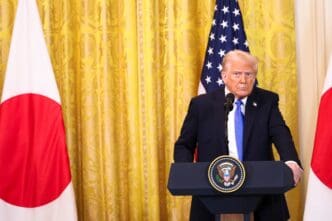Executive Summary
The Story So Far
Why This Matters
Who Thinks What?
Japanese Prime Minister Sanae Takaichi, who took office on Tuesday, has formed a new hardline coalition, ending a 26-year alliance with the pacifist-leaning Komeito party. The move is expected to unshackle her security ambitions, though her government’s parliamentary minority presents a significant challenge. Takaichi is preparing for her first major diplomatic test next week: face-to-face talks with U.S. President Donald Trump, where she anticipates pressure on defense spending.
New Coalition and Security Ambitions
Takaichi replaced Komeito with the right-wing Japan Innovation Party, known as Ishin, a shift that aligns with her conservative agenda. Analysts suggest this change removes Komeito’s traditional role as a brake on defense policy. Both Takaichi and Ishin advocate for revising Japan’s pacifist constitution and strengthening the military.
The new coalition aims to accelerate Japan’s largest military buildup since World War Two, potentially doubling defense spending to 2% of GDP. Ishin has even proposed a U.S.-style nuclear-sharing deal, a radical departure from Japan’s long-held non-nuclear principles. Takaichi has also stated that a “contingency” in Taiwan would be a contingency for both Japan and the United States.
Regional Implications and China’s Response
China has expressed concern regarding Japan’s commitment to peace and self-defense following Takaichi’s ascendance. Chinese Foreign Ministry spokesperson Guo Jiakun urged Japan to “reflect on its history of aggression, adhere to the path of peace, and exercise caution in its words and deeds in the field of military and security.” Takaichi is a frequent visitor to the Yasukuni war shrine, which Beijing views as a symbol of past militarism.
Managing relations with China is expected to be a major hurdle, particularly with the loss of Komeito, which maintained ties with Beijing. The upcoming meeting with President Trump will allow Takaichi to outline her regional security goals before he meets Chinese leader Xi Jinping next week ahead of the annual Asia-Pacific Economic Cooperation (APEC) summit in South Korea.
Domestic Constraints and Diplomatic Strategy
Despite her strong security stance, Takaichi’s government holds a parliamentary minority, making it reliant on opposition support to pass key bills. This domestic weakness could limit her ability to make ambitious promises on defense spending to President Trump. Professor Ryo Sahashi of Tokyo University noted that while accelerating the buildup is likely, a significant jump in the budget to “3% or 5%” would be difficult for a government with such a weak footing.
To secure President Trump’s favor and potentially bolster her domestic standing, Takaichi reportedly plans to present a package of U.S. purchases. These include Ford F-150 pickup trucks, soybeans, natural gas, and a list of potential U.S. investments.
Outlook for Japan’s Foreign Policy
Prime Minister Takaichi’s new coalition signals a decisive shift towards a more assertive security policy for Japan. However, her diplomatic debut with President Trump will be shaped by both her ambitious agenda and the inherent fragility of her parliamentary minority, requiring a delicate balance between international commitments and domestic political realities.








